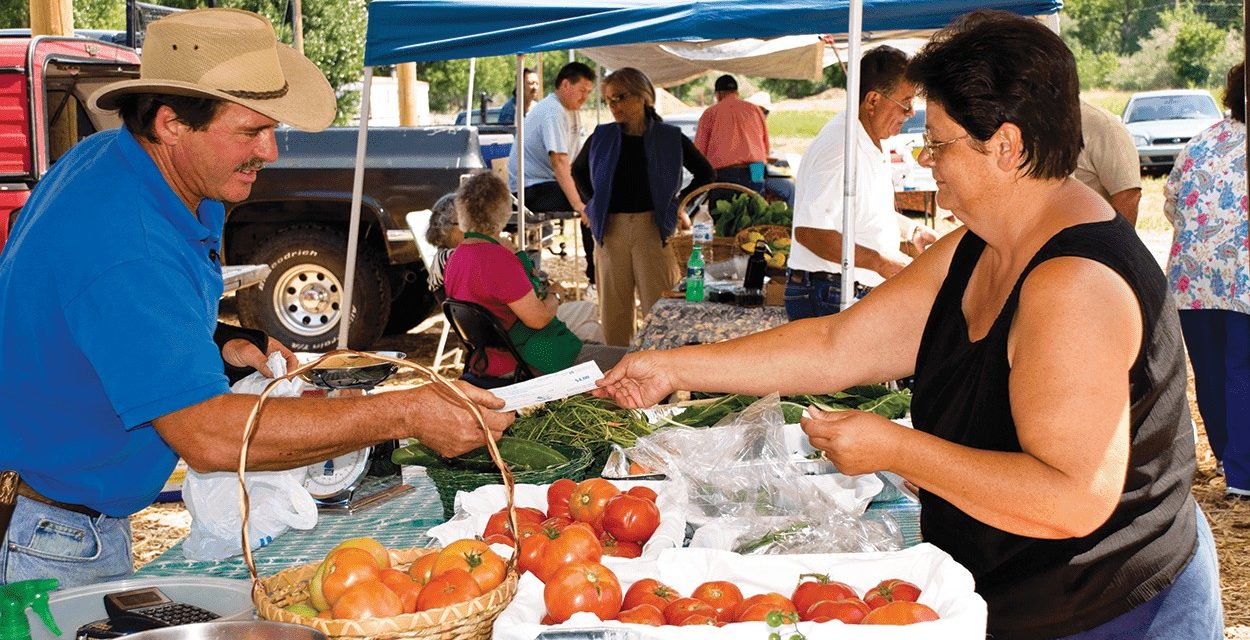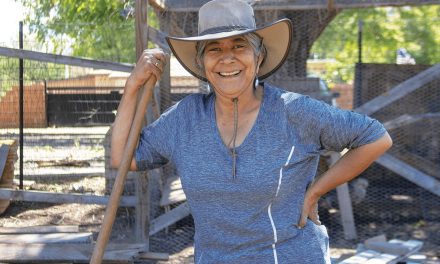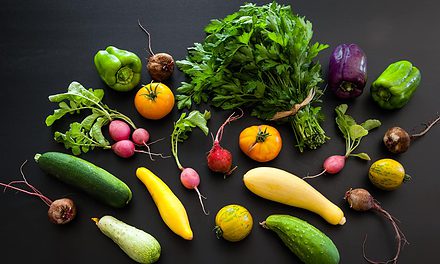Farm Bill’s SNAP Cuts Would Hurt New Mexico

Exchanging a WIC check at the Española Farmers Market.
Photo courtesy of the New Mexico Farmers’ Marketing Association.
In certain ways, Socorro County can be considered New Mexico’s heartland. It is in the center of the state, about fifty miles south of Albuquerque hugging I-25 and the Rio Grande. Like the majority of New Mexico, its communities are rural, with plenty of country charm exhibited at local events—rodeos, farmers markets, 4-H auctions. Well over one million acres of farmland are set aside for cattle, alfalfa, chile, wheat, corn, and other crops that feed bellies across the country. With such a strong agricultural identity, Socorro County residents should be paying close attention to ongoing ag policy debates in Congress over the new Farm Bill, which is set to replace the current bill when it expires in September. However, agricultural policy isn’t all they should be concerned about. Despite being surrounded by food production, twenty-two percent of Socorro’s population faces food insecurity and relies on the Supplemental Nutrition Assistance Program (SNAP)—a program that has been paid for by the Farm Bill, but is now in jeopardy.
The Farm Bill is one of the country’s most important and expensive pieces of legislation, yet many of us don’t have a clear understanding of what it does. The bill essentially has three main goals: to aid farmers in order to protect our food supply and economy; to protect the environment; and to feed the hungry. The nutrition component dwarfs the others, with eighty percent of the Farm Bill’s $430 billion five-year budget going toward SNAP and other nutrition programs. The Farm Bill originated during the Great Depression and Dust Bowl with the Agricultural Adjustment Act, which helped stabilize crop prices and feed the poor. Over the years the Farm Bill has changed in size and scope: the Food Stamp Program was folded into the Farm Bill in 1977; Congress began including conservation measures in the 1980s; and in the 1990s and 2000s provisions for a greater focus on tribal and other underserved communities led to funding for land-grant colleges, technical assistance, and outreach to help ensure the sustainability of the farms and the people who work the land.
Every five years the Farm Bill expires and must be updated, debated, and passed through Congress. Both the Senate and House must draft and pass their own versions of the bill, then work together to reconcile the two before sending it to the president for signature. Historically, the bill has been a relatively bipartisan effort, with Republicans and Democrats compromising on issues such as farm subsidies, crop insurance, natural resource conservation, rural development, trade, energy, labor safety, and nutrition programs. This year, as with the last Farm Bill in 2014, partisan debate over SNAP spending has made the bill more divisive.
On June 21, the House narrowly passed its Republican-led version of the 2018 Farm Bill, 213–211. All House Democrats and twenty Republicans voted against the bill, and New Mexico Congressman and gubernatorial candidate Steve Pearce (R-NM) voted in favor. If enacted, the House bill would cut SNAP spending by an estimated $20 billion over the next decade, largely by limiting eligibility through stricter work requirements. Some one to two million people would be forced out of the program. About $8 billion of those savings would go toward work training programs and administrative costs. While House Republicans and President Trump claim the restrictions will lead to greater self-sufficiency, opponents point to research that suggests these short-term training programs have proven ineffective in helping the unemployed find work, and believe long-term solutions to unemployment are more likely to be found through training in high-demand sectors and access to affordable education, child care, and transportation.
Under the existing 2014 Farm Bill, able-bodied adults without dependents (ABAWDs) between the ages of eighteen and forty-nine are already required to work part-time or participate in a work-training program to receive food stamps, and must agree to accept a job if offered. Otherwise, they will lose benefits after three months. The 2018 House bill will raise the maximum age to fifty-nine, with exceptions for pregnant women, caretakers of children under six, or persons with disabilities. (Critics argue the definition of those considered disabled is too narrow, often not including individuals with some mental illnesses, such as veterans suffering from undiagnosed PTSD.) New stipulations will punish anyone who fails to comply with the work requirements by dropping their coverage for one year for the first infraction, and three years for each subsequent violation. The House proposals would also drastically cut school free-lunch programs and remove waivers that currently allow states facing high unemployment rates to avoid federal penalties for noncompliance. New Mexico has the second-highest unemployment rate in the nation, doubling and tripling the national average in some rural counties. Our state is the third-highest food stamp user per capita.
Forty-two million Americans use SNAP to buy groceries, including about 450,000 New Mexicans. Despite persistent misperceptions depicting food stamp users as “moochers” and “welfare queens,” the vast majority locally and nationally are elderly, disabled, or are children (forty percent of our state’s young children receive SNAP). Despite the rhetoric one often hears, only seven percent of beneficiaries fall into the ABAWD category. About half of SNAP users come from working families. Maria Griego of the New Mexico Center on Law and Poverty (NMCLP) explains: “For hundreds of thousands of New Mexicans, work does not itself guarantee steady or sufficient income to provide for families. SNAP helps one in seven workers in New Mexico [who] turn to SNAP to supplement low and fluctuating pay and to help their families get by during spells of unemployment.” The average SNAP family in New Mexico uses the assistance for only fourteen months.
Critics of the House Farm Bill say rigid twenty-hour-a-week work requirements are unrealistic for states like New Mexico where full-time and living-wage jobs are difficult to come by. They say by removing the waivers and the state’s power to implement its own work and work-training criteria, many deserving individuals will go hungry. Griego says that “these types of requirements are particularly untenable for Native American nations who have their own governments that know best how to tackle food insecurity and workforce development in their own communities.” Under this plan, an estimated 120,000 New Mexicans could face termination of SNAP, and tens of thousands would see reduced benefits. According to gubernatorial candidate and Representative Michelle Lujan Grisham (D-NM), the new House stipulations and red tape (such as providing a monthly utility bill) would “further destabilize an already disjointed SNAP system in New Mexico.” The Congresswoman adds, “[These] draconian cuts to SNAP create an unfunded mandate [and would] waste $7.6 billion on creating an untested and unchecked workforce bureaucracy at the state level.”

Photo courtesy of the New Mexico Farmers’ Marketing Association.
After the initial failure of the House Farm Bill in May, Representative Pearce said, “In New Mexico, too many are trapped in poverty, and we owe it to them to help provide a pathway to success and prosperity. The job training and work requirements added would have helped New Mexicans learn the skills needed to succeed and to lift themselves out of poverty.” After the subsequent passage of the House bill, Krysten Aguilar, Director of Operations and Policy Advocacy of La Semilla Food Center in Anthony, countered, “It is offensive when Pearce assumes that New Mexicans are not already trying to find work and enter job training programs. These [new] programs are not yet in place, and when Pearce brags that 116,800 New Mexicans would qualify for them, what that really means is that 116,800 might lose their benefits if New Mexico is not prepared to accept [them] into job training programs within a few months. Until that infrastructure is in place, it is irresponsible—and arguably cruel—to make people depend on them in order to eat. . . . If the Representative honestly wanted to create a ‘pathway to success and prosperity,’ he would increase access to food, not reduce it, and he would introduce a Healthy Food Financing Initiative for New Mexico.” She adds that Pearce’s support of the “devastating” bill shows that he is “deeply detached from the lives of his constituents.”
Indeed, proposed cuts to SNAP funding would hit rural New Mexicans especially hard. In Representative Pearce’s District 2—which encompasses the largely rural southern half of the state including Socorro County—at least 162,393 New Mexicans participate in SNAP, according to the NMCLP. Certain aspects intrinsic to rural areas make it especially hard to comply with work and training mandates. Rural areas have been slower to recover from the 2008 recession and have experienced significant population loss in the last decade, prompting a decline in manufacturing, construction, and service jobs. Work-training programs are also less present in rural areas, requiring residents to travel great distances to participating offices. That travel may prove impossible for some because reliable public transit is nearly nonexistent in isolated areas. For Native American SNAP participants living on tribal lands, this may require moving away from family to more urban areas, something Native American food sovereignty lobbyists have likened to Relocation Policy. (Over seventy-five thousand SNAP participants in New Mexico are Native American.) Searching for employment is also greatly hindered by limited internet access. And for rural farm workers, the seasonal nature of agricultural work puts them at greater risk of violating short grace periods.
SNAP dollars are also critical to the survival of rural grocery stores, which service populations experiencing higher rates of poverty. In Socorro, for example, there are only two supermarkets, Walmart and the locally-owned John Brooks SuperMart. Dan Smiel, operations manager for John Brooks in Socorro, says that SNAP dollars account for ten to fifteen percent of monthly sales, and they are “very important to all [John Brooks] stores.” He says without SNAP dollars the Socorro location would likely have to let go of five or six of their thirty-five to forty employees. According to the Rural Grocery Store Initiative out of Kansas State University, rural and small town grocers are already disappearing at an alarming rate. This increases shoppers’ travel times and expenditures, limits the amount of fresh foods consumed, and jeopardizes job opportunities.

Last year, over $650 million in SNAP benefits was spent at New Mexico food retailers. But SNAP dollars don’t just result in increased food sales, they also allow families to spend more income on non-food items and services, providing a much-needed economic boon to struggling communities. Studies have repeatedly shown that this type of “trickle-up” economics is critical in times of economic downturn, as poor households spend their money quickly, injecting it back into the community, as opposed to tax-break dollars given to wealthier Americans who are more likely to put it into savings.
People often remark that the name Farm Bill is a misnomer because so much of the funding doesn’t directly go to farms. However, nutrition program dollars are good for farmers, too. One example in New Mexico is the SNAP incentive program, Double Up Food Bucks, which is funded through the Farm Bill, as well as the state and other partners. This program, first implemented in 2015, allows individuals to double their SNAP dollars when they spend them on locally grown fruits and vegetables at farmers markets. In surveys conducted by the New Mexico Farmers Market Association (NMFMA), seventy-three percent of local farmers say they have seen an increase in produce sales because of the program and seventy-eight percent of shoppers say they are buying and eating more fruits and vegetables. According to Sarah Lucero of the NMFMA, “SNAP cuts would have a huge economic impact on New Mexico. Every SNAP dollar spent generates $1.70 in economic activity . . . and Double Up Food Bucks doubles any amount of SNAP dollars spent at participating locations on New Mexico grown fruits and veggies—which helps farmers grow their small businesses and keep that extra $1.70 in the local economy.” In addition to forty participating farmers markets, in 2017, nine grocery stores, nine farm stands, and several mobile markets and CSAs also accepted Double Up Bucks. This includes MOGRO, a mobile grocery service that brings fresh produce boxes to food insecure areas such as Socorro. In addition to “struggling families trying to make ends meet,” Aguilar says Representative Pearce’s support of the House bill “shows a complete disregard for the well-being of farmers in his district.”
Although the House plan has many Americans worried, on June 28 the Senate passed its own version of the 2018 Farm Bill, 86-11, which leaves the 2014 Farm Bill SNAP requirements intact. Though few find their bill perfect, the Senate’s self-proclaimed “bipartisan bill” has received praise from national and New Mexico food security advocates, including the Native Farm Bill Coalition and the NMCLP. Maria Griego says, “The final version of the Senate Farm Bill strengthens SNAP and protects millions of Americans’ access to healthy food.”
All of this has set the stage for a showdown between the House and Senate in the coming weeks. By the time this issue goes to print, the two bills may be reconciled—or it is possible congressional debates will carry on past the September 30 deadline, leaving plenty of time for edible readers to contact their local representatives. Griego says, “Instead of trying to cut SNAP, lawmakers should focus on bipartisan legislation that grows income and employment opportunities for all New Mexicans through policies that actually work. We urge Steve Pearce and other lawmakers to stop supporting such damaging legislation and, instead, to strengthen SNAP and ensure families across New Mexico can meet their basic needs.”
www.nmpovertylaw.org, www.lasemillafoodcenter.org,
www.farmersmarketsnm.org
Candolin Cook is a historian, writer, editor, and former co-editor of edible New Mexico. She recently received her doctorate in history from the University of New Mexico and is working on her first book.













